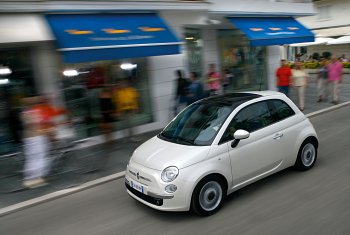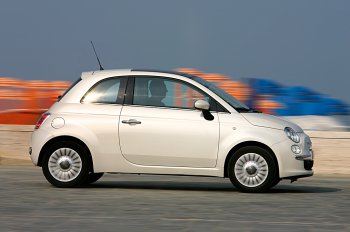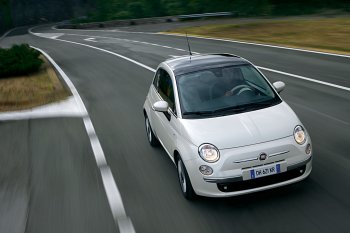|
GREEN ENGINES
|
|
The car comes
with a choice of superb modern engines that guarantee
sparkling performance. There are two petrol units (the 69
bhp 1.2 8v and 100 bhp 1.4 16v) and one Multijet
turbodiesel, the 75 bhp 1.3 16v with DPF. Each offers
different features, all of which are exploited fully by
combining them with mechanical 5 or 6 speed gearboxes (a
Dualogic sequential robotised 5-speed gearbox will also be
available at a later date for the petrol engines), and they
stand out for their generosity, brilliant temperament, top
performance and advanced technology. However they all also
share top reliability and respect for the environment. This
has been demonstrated in over 1,600,000 km that the test
cars have already travelled, which will become 2,350,000 km
with the last tests. We should underline that all the
engines are Euro 4-compliant and are designed to meet the
even stricter limitations of future European standards (Euro
5), already meeting the emissions limits that will
presumably be enforced in 2009. The 1.3 Multijet is also
equipped with a particulate trap (PDF) as standard
equipment.
All the engines mounted on the Fiat 500 are manufactured by
Fiat Powertrain Technologies, the Group’s new sector. FPT
draws together all the activities in the fields of
innovation, research, design and manufacture related to
engines and gearboxes for all types of applications: from
cars to commercial vehicles, boats and agricultural
machinery. With approximately 19,000 employees, 17 plants
and 10 research centres in eight different countries, the
Sector is one of the world’s most important organisations in
its field. At FPT, approximately 3000 highly specialised
technicians focus on the development and engineering of
innovative technologies. More than 40 patents are filed each
year, confirming the quality and seriousness of this
commitment, and making FPT a huge centre of technological
excellence and ongoing innovation.
The 69 bhp Fire 1.2 8v
The tried and tested Fire engine that will power the Fiat
500 has a capacity of 1242 cc, and has undergone a series of
refinements designed to make it a champion of fuel economy,
but without detracting from performance. The engine delivers
51 kW (69 bhp) at 5500 rpm, and peak torque of 102 Nm (10.4
kgm) at 3000 rpm, with a top speed of 160 km/h. That is not
all. With the 1.2 8v engine, the Fiat 500 leads its class
for consumption, delivering 5.1 l/100 km in the combined
cycle, with CO2 emissions of 119 g/km. Acceleration over 100
metres is also excellent at 12.9 seconds. This figure is
even more significant in view of the car’s low consumption.
The credit goes to the structure of the engine, which
achieves a generous torque at low revs (this makes for more
enjoyable driving and outstanding flexibility) and ratios
chosen to highlight fuel economy.
A sparkling engine that is sparing on fuel. This has been
achieved thanks essentially to: 1) The adoption of an
electronic throttle valve control system known as ‘drive by
wire’ (with no mechanical connection between the accelerator
and the throttle), while it is the electronic control unit
that delivers the torque on the basis of the driver’s
demands (torque-based system). 2) Fluid dynamic optimisation
achieved by a new high turbulence combustion chamber
combined with a continuous variable cam phaser. This
innovative system allows a substantial part of the exhaust
gases (about 25%) to be recirculated in the combustion
chamber, significantly reducing fuel consumption and exhaust
emissions when driving with a partial load. 3) The timing
components have been made lighter and the valve springs are
of the low load type, to reduce friction.
Another interesting feature of this engine where fuel
consumption is concerned, is the use of an active knock
sensor capable of managing the advance in the best possible
way in all conditions and, above all, the multipoint
sequential phased injection system by Magneti Marelli. The
quality of life on board has also been improved by
optimising the performance of the intake and exhaust
systems, optimising the coupling play between the crankshaft
and crankcase, through the computerised selection of the
main bearings, and the development of a specific
installation of the engine in the engine bay. This keeps the
transmission of vibration from the engine to the bodyshell
to a minimum. A special engine support system has been
adopted, that comprises two blocks and a reaction link,
which acts as a tie rod, in which the new bearings are
aligned on an axis that goes through the engine’s centre of
gravity in order to obtain reaction forces with a neutral
arm.
On the environmental front, the 1.2 8v fits a catalytic
converter in the engine bay, welded to the exhaust manifold
flange. In this position the device is extremely efficient
because it reaches high temperatures very rapidly thus
abating emissions even while the engine is warming up. The
engine has been made even more reliable. The coils have been
mounted closer together in a single block. This new type of
coil means less spark plug wear, more energy available to
ignite each plug thanks to the elimination of the lost
spark, better cold starting due to the additional energy
available for the spark plug (more energy supplied by the
coil and no losses caused by the transfer of high voltage
due to the adoption of very short cables), and finally, a
significant reduction in the risk of disturbance to the
onboard instruments due to high voltage cables.
The 75 bhp 1.3 Multijet 16v
The Fiat 500 would not be complete without the 1.3 16v
Multijet engine, the smallest and most advanced second
generation direct injection Common rail diesel unit, of
which more than two million have been built to date. Fitted
with a Borg-Warner fixed geometry turbo (of the waste-gate
type) with an intercooler, the engine delivers a maximum of
75 bhp (55 kW at 4000 rpm) and torque of 14.8 kgm (145 Nm)
at 1500 rpm. With this engine, the Fiat 500 guarantees
excellent performance: it has a top speed of 165 km/h and
accelerates from 0 to 100 km/h in 12.5 seconds. Fuel
consumption is also among the best for this segment: 5.3
l/100 km in the urban cycle, 3.6 l/100 km out of town and
4.2 l/100 km in the combined cycle, and CO2 emissions are
among the lowest on the market at just 111 g/km.
The engine is a straight-4 with a capacity of 1248 cc, a
bore of 69.6 mm and a ‘long’ stroke of 82 mm. There are four
valves per cylinder, governed directly by a twin overhead
camshaft with maintenance-free hydraulic tappets and
automatic play take-up. That is not all. The 1.3 Multijet
16v is a miniature masterpiece: ‘dressed’ with all its
accessories, it weighs just 130 kg, it is small, just 50 cm
long and 65 cm tall, and the component layout was designed
to take up as little space as possible. Designed by criteria
of maximum rationality, efficiency and reliability, the
engine guarantees excellent efficiency and is practically
‘for life’: it was designed to travel 250,000 km without
needing any maintenance to the mechanical components.
The compact, sophisticated engine is also extremely
eco-friendly, thanks to an emissions control system that
envisages an EGR valve triggered electronically and managed
directly by the engine control system, a heat exchanger to
cool recirculating exhaust gas (EGR) and a ‘close coupled’
catalytic converter. A particulate trap (DPF), the ‘for
life’ system that abates fine dust and does not need
additives to be regenerated, is standard equipment.
The 75 bhp 1.3 Multijet 16v therefore represents a
technological leap forward which, for the customer,
translates into lower consumption and emissions, without
even taking into consideration the reduction in noise (due
to the multiple injections), the increase in comfort (fewer
alternating masses means less vibration), the smooth,
responsive steering (due to the really smooth torque
delivery, which is guaranteed by the improved combustion
control), the elasticity and prompt response of a diesel
that resembles a petrol engine for the vast excursion in the
number of revs (for example, you are no longer aware of the
fuel ‘cut-out’ just above 4000 rpm).
|

 |
|
Each of the three 500 engines offers different
features, all of which are exploited fully by
combining them with mechanical 5 or 6 speed
gearboxes (a Dualogic sequential robotised 5-speed
gearbox will also be available at a later date for
the petrol engines), and they stand out for their
generosity, brilliant temperament, top performance
and advanced technology. |
|
|
 |
|
|
 |
|
The car comes
with a choice of superb modern engines that guarantee
sparkling performance. There are two petrol units (the 69
bhp 1.2 8v and 100 bhp 1.4 16v) and one Multijet
turbodiesel, the 75 bhp 1.3 16v with DPF. |
|
 |
|
|
And the ecological elements that enhance the diesel’s main
environmental credentials (consumption) while minimising its
main defect (particulate emissions).
The 100 bhp 1.4 16v Fire
engine
One hundred horsepower on hand on such a compact car points
up a brilliant, agile character, which allows it to slip
easily and cheerfully through congested town traffic. The
engine has a capacity of 1368 cc and four cylinders in line,
with a bore of 72 mm and stroke of 84 mm. There are four
valves per cylinder, driven directly by the overhead
camshaft. The engine was developed focusing particular
attention on performance and consumption, fields in which
the Fiat 500 leads its class. All credit to the volumetric
efficiency which has been optimised throughout the operating
range, thanks to careful fluid dynamic development of the
entire intake system and timing phasing.
The 1.4 16v delivers a maximum of 73.5 kW (100 bhp) at 6000
rpm and peak torque of 131 Nm (13.4 kgm) at 4250 rpm.
Performance is excellent: the new car has a top speed of 182
km/h, and accelerates from 0 to 100 km/h in 10.5 seconds. It
is a sparkling engine with excellent performance enhanced by
an electronic throttle valve control system known as ‘drive
by wire’. This engine also proposes a number of changes that
help to keep consumption down. For example, the timing
components have been made lighter and the valve springs are
of the low load type, to reduce friction.
Other features of the new 1.4 16v Fire are the increased
compression ratio and the generous torque at low engine
speeds, characteristics that have made it possible to limit
consumption: for example, in the combined cycle it returns
6.3 l/100 km. This target was achieved by the calibration of
the latest generation engine control system, which succeeded
in reducing consumption as much as possible, compatible with
the requirements of driveability, performance and emissions.
In order to guarantee low emissions, special injectors have
been adopted that optimise the spray phase, thus reducing
the quantity of petrol that adheres to the walls of the
intake manifold during cold starting and in transients (when
you depress the accelerator). This reduces the quantity of
hydrocarbons in the exhaust, guaranteeing respect for the
environment and for increasingly stringent legislation.
Reliable, robust gearboxes
A range of reliable, robust, sophisticated gearboxes has
been developed to match the engine range available on the
Fiat 500: one is a mechanical unit (with 5 speeds for the
1.2 and 1.3, and with 6 speeds for the 1.4), the other is of
the sequential robotised type, and will be available after
the launch on petrol-engined versions. The mechanical
gearbox is very compact and gear-shift manoeuvring is
excellent. This was made possible by the reduced inertia of
the driven clutch plate and the introduction of new seals.
The gearbox configuration is transverse with two cascade
shafts, while the speed control is internal, with four
selection levels.
The external drive is dual hose type, which filters out
engine running roughness and vibration transmitted by the
engine to the gear lever. The gears have teeth with extra
covering, as well as fifth speed and final drive pairs that
are given an extra finish after heat treatment (this
improves quiet operation). The gearbox housing is light and
absorbs noise efficiently, and has been fine tuned using the
Finite Element Method. The mechanical gearbox of the Fiat
500 has a ‘syringe’ mechanism that prevents the involuntary
engagement of reverse.
The Dualogic gearbox is a jewel of mechanical engineering
and deserves a separate mention. It will be available after
the launch combined with the mechanical gearbox that equips
the 1.2 8v and 1.4 16v versions and it features an
innovative transmission system. It automates the clutch and
gear lever controls by means of an electrohydraulic servo,
but maintains all the advantages of a dry clutch and a
mechanical gearbox (weight, sturdiness and reliability, low
energy consumption). This sophisticated system improves the
performance of the manual mechanical transmission components
and increases driving safety because it avoids errors by the
driver and prevents faulty manoeuvres of the transmission
system.
There are two operating modes: semiautomatic and automatic.
The first adopts the most advanced control strategies to
guarantee the best performance. Gears are engaged using the
lever on the facia. Because there is no clutch pedal, the
device is controlled simply by moving the lever: forward to
change up (towards the ‘+’ symbol), back to change down
(towards the ‘-‘ symbol). A simple push is sufficient to
ensure the transmission makes a fast, accurate gear change.
This is how the Dualogic transmission functions in
semiautomatic mode. Most of the electric signals reach the
control unit by CAN (Controller Area Network) and can be
grouped in two large subgroups. In one, the data from the
gearbox area, which make it possible to identify the
engagement position, the selection, the clutch, and the
operating pressure of the hydraulic kit, as well as the
rotating speed of the clutch. In the other, all the signals
coming in from the control lever on the tunnel or the levers
on the steering wheel (which are optional), that let the
driver decide when he wants to change gear, and those from
the other systems on the Fiat 500 (for example, the engine
and braking system), which help to define the gear change
precisely and repeatably. For example, coordination with the
engine control unit makes it possible to change up without
having to release the accelerator pedal or to automatically
increase engine speed when changing down (double de-clutch).
Using these two groups of signals, the Dualogic gearbox can
manage gear changes in a comfortable or sporty way, in the
manual or automatic mode, interpreting the driver’s needs by
analysing the pedal position and the engine speed.
Once the engine on the Fiat 500 is started, any pressure on
the brake pedal confirms that the driver is at the wheel,
and enables first or reverse to be engaged (on a slippery
surface it is also possible to set off in second). And to
guarantee safety and prevent incorrect gear engagement, the
system engages neutral automatically when a door is open
with the engine running. The Dualogic device also prevents
errors that might damage the engine or gearbox, by notifying
the driver of emergency situations or incorrect manoeuvres
with warning lights and beeps.
The automatic mode of the Dualogic system offers two
settings on the 1.2 version: Normal and Economy. The Normal
setting provides outstanding driving comfort, with brilliant
acceleration and gear changes in all conditions. The Economy
setting, on the other hand, is used to reduce fuel
consumption, while still maintaining outstanding handling
and comfort. On the version for the 1.4 16v engine, the two
settings are Normal and Sport (with the Sport button on the
facia). The Sport setting activates a faster gear change
logic that minimises the torque gap and thus makes the car
more ‘fun to drive’ for the driver.
In automatic mode, the system recognises the road gradient
(by means of a software algorithm) and modifies the gear
shift point to ensure the best possible compromise between
the driver’s needs, ground conditions and vehicle situation
(speed and engine rpm). Another feature peculiar to the
Dualogic gearbox is its ability to measure the vehicle
deceleration and adapt gear changes accordingly. For
example, in semiautomatic mode, and particularly with a
sporty driving style, the system changes down when the
driver asks for a lower speed to take a corner with more
gusto. In automatic mode, the system anticipates the change
down so that the driver has the best speed to maintain the
level of comfort or fuel economy. The Dualogic system is the
best compromise for drivers who prefer the enjoyment and
entertainment of a manual shift, but like to know they can
count on the convenience of an automatic. |
|